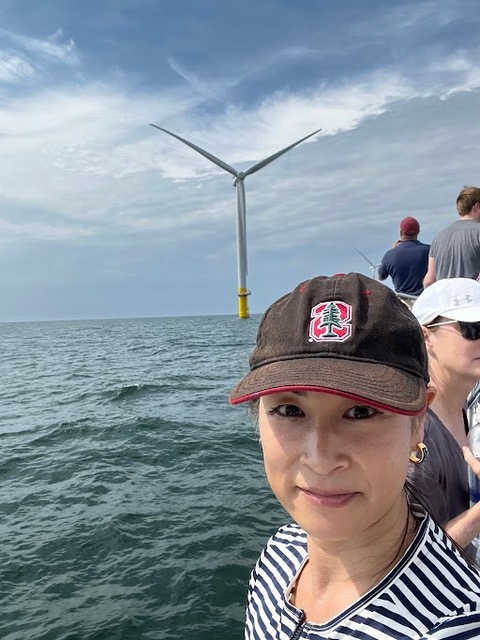Christine Harada was named in July 2021 by President Joe Biden as the first permanent executive director of the Federal Permitting Improvement Steering Council, created to expedite infrastructure project permit approvals involving federal lands and/or multiple agencies. The little-known program, called FAST-41, dates to 2015 when it began as a pilot under Title 41 of the Fixing America’s Surface Transportation Act to test more efficient environmental review procedures for selected projects and insure agencies are ready sooner for project approval tasks. The council, which was made a permanent entity in 2021 with passage of the Infrastructure Investment and Jobs Act, now oversees more than $100 billion worth of projects and includes representatives from 13 federal agencies and the White House. It updates a website on the status of projects with portals to gain information and voice concerns.
Previously, Harada was vice president for government affairs at Heliogen, a California renewable energy technology firm. As federal Chief Sustainability Officer under President Barack Obama, she oversaw all federal sustainability-related initiatives in energy and vehicle fleet management. Harada also held top policy and management roles at the U.S. General Services Administration and is a former senior systems engineer at Lockheed Martin. Harada spoke with ENR correspondent Mary Powers about how the council operates to usher projects to the permitting finish line.

Council Executive Director Christine Harada visited site of a pilot 12-MW offshore wind energy site in Virginia—a precursor to a 2.6 GW project being developed nearby by utility firm Dominion Energy that now seeks federal permits.
Photo: Federal Permitting Improvement Steering Council
ENR: What were your marching orders to help clear the way for smoother, faster permitting?
Harada: The council stands up for all federal environmental reviews. We are a lot like a front-office consultant in the upfront permitting stage for transmission, pipelines, mining and other projects. Federal transportation and Water Resources Development Act infrastructure projects are excluded since they are covered under other federal laws. Because of the council’s unique role and composition, we [can] identify, diagnose and resolve issues that lead to permitting delays and inefficiencies across the U.S. government—which are attributed to insufficient agency capacity or capability; insufficient information submitted by permit applicants; and impediments to effective agency and interagency coordination.
How has the FAST-41 process been successful?
Harada: We have finished permitting 31 projects worth $167 billion, and are in the process of permitting 31 others. We permitted four projects so far this year worth a total of $40.4 billion: South Fork Wind, a 132-MW offshore wind project off the New York coast; the Ten West Link 125-mile, 500 kilovolt transmission project in California; the $2.5-billion Mid-Barataria sediment diversion and coastal restoration project in Louisiana; and Alaska LNG, which includes natural gas production, export and pipeline infrastructure. South Fork Wind is the first of 16 FAST-41 covered projects in the U.S. offshore wind sector on track to complete environmental review and authorization in the Biden administration. The $1.7-billion South32 Hermosa underground manganese and zinc mine and processing plant also became the first critical mineral project to be covered by FAST-41 earlier this year. President Biden has committed to securing a domestic supply of responsibly sourced critical minerals ... as a key part of the electric vehicle and stationary storage battery supply chain. Congress recognized the success and has made the program permanent. We help make it real on the ground. We’re now at the point where the money is here and we have to permit these projects.
How does the council operate to expedite permits?
Harada: We are a council that includes the deputy secretary or equivalent of 13 federal agencies and two White House leaders. They are the senior-most decisionmakers focused on infrastructure projects. Our emphasis is on process and schedule. We meet monthly with developers to help them understand exactly what needs to be done. We get the views from agencies about data and services needed to develop a path forward. The process is voluntary for project sponsors, and it doesn’t change any underlying regulations that projects have to comply with. We do not cut corners. We don’t give short shrift to any environmental reviews, authorizations or statutes. The primary [time] savings we have been able to achieve thus far have been largely just due to pure and simple coordination. This differentiates FAST-41 and the council from other streamlining efforts that sometimes seek to achieve speed, rather than efficient deliberation, through imposition of arbitrary deadlines, truncated analyses and penalties.
What steps do you take when projects need your help?
Harada: We look at the permit critical path, where council assistance is most needed and how I can elevate issues to get them resolved quickly. We are a relatively small team and I can figure out when and where issues need to be escalated. The legacy culture at agencies is that if you escalate an issue, you’re not doing your job. That’s not so. My role is to elevate issues to higher levels if agencies are at an impasse. We help untangle tricky situations and bring closure—to achieve a ‘no’ or ‘yes’ decision and make it accountable. Coordination is nuanced to make sure agencies don’t add layers of issues or question each other’s authority.
How does the council work to resolve a developer's project permit challenges?
Harada: For renewable energy projects such as offshore wind, we are a ‘sherpa guide’ for European companies that are not used to U.S. environmental regulations. We help them sort out the puzzle of data they need to push forward. The
scale makes it challenging. We help with the process. For example, in
remote areas, it’s hard to get the right biologists on site since their
role is voluntary. The project sponsor must ask for our help. We also explore ways to help tribes with limited resources use mechanisms to obtain needed federal funding, and boost engagement up front with communities that would be impacted by projects. I also can transfer funds to agencies to increase the [process] efficiency by alleviating resource constraints. Agencies clearly are taking a more active role in managing their permitting timetables, and instances of “missed” dates have significantly decreased.
Is there ever any reluctance by developers to use your help?
Harada: Not all developers want to participate because they want to proceed in stealth mode, they don’t want to be a political football or they think they do not need any assistance. But often six months later, they come back to seek our help. [Transmission line developer] SunZia initially was not sure it wanted to get involved in what it thought was another bureaucracy. But company managers now speak glowingly about us [after] a U.S. Senator pushed them to use our services. We got parties together at the same time and addressed issues as a team. There has been a recent uptick in interest from renewable energy projects, broadband in Alaska and critical mineral development.
How will the permit reform provisions added to the Fiscal Responsibility Act signed June 3 by President Biden, which elevates the debt ceiling for two years, affect your work?
Harada: The law has a new provision that clarifies that energy storage projects are covered by FAST-41. Covering them means that projects set to cost more than $200 million are subject to permitting and environmental review provisions of that statute. The new law makes clear that storage, which is key for clean energy use on U.S. grids, is covered permanently. That clarity can help with clean energy investments that we need to address climate change. We do not anticipate any procedures changing as a result of the new law. There was no additional funding appropriated to the council in the law.
What impacts or complications do you see for Council project permitting based on changes in wetland delineation and scope of federal protection as a result of the new US Supreme Court ruling in Sackett v. EPA?
This remains to be seen. At the moment, with our current project portfolio, we do not foresee any impacts or complications.
Are you making investments to make permitting more streamlined?
Harada: We continue in our efforts to prioritize investments in the federal permitting process, such as in tools, like GIS, to facilitate the federal review process. We hold workshops and training sessions, looking at what we need from state agencies for permitting and at how to educate federal permit managers in the nuances of new industries. In offshore wind, for example, regulators want to know why a developer can’t use bigger turbines, what role power offtake agreements play in project success and how supply chain arrangements are structured. We’re investing in permit support system improvements on a holistic level.
What’s coming next?
Harada: This is the first time that project permitting has received this level of attention and empowerment from top levels of the government. But more reform is needed. The administration is ready to work with Congress on a bipartisan basis to pass thoughtful permit reform that brings our laws into the 21st century, and puts science and people first.





Post a comment to this article
Report Abusive Comment